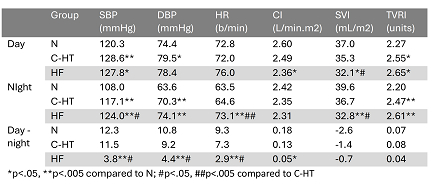Final ID: Su2163
Abnormal day-night blood pressure and systemic hemodynamics in heart failure compared to normotension and controlled hypertension
Abstract Body (Do not enter title and authors here): Background: High night-time BP and heart rate (HR) and insufficient decreases (“non-dipping”) in night-time BP and HR are markers of high morbidity and mortality. Non-dipping has been reported in some patients with hypertension (HT) or history of acute heart failure (HF) but the underlying derangements in ambulatory systemic hemodynamics have not been described.
Aims: Present studies were undertaken to confirm whether patients with history of HF have abnormal dipping of BP and HR and to identify potential differences between day and night ambulatory hemodynamics in HF, normotensives (N), and controlled HT (C-HT, 24-hr systolic BP<135 mHg).
Methods: Ambulatory BP-pulse wave readings (PWA, ARCSolver/Mobil-O-Graph) were taken every 20 minutes for 24 hrs, with day and night values averaged. Variables of interest included systolic and diastolic BP (SBP and DBP), HR, cardiac index (CI), stroke volume index (SVI), and total vascular resistance index (TVRI). Groups were compared by ANOVA/Bonferroni. HF patients were further characterized by echo ejection fraction (EF) as preserved (HFpEF) or reduced (<40%, HrEF).
Results: Data were obtained from 138 individuals (N 39, C-HT 63, and HF 36); main results are summarized in the Table. Night SBP was higher in HFpEF than HFrEF but both had persistently low SVI and high HR and TVRI. In those with echo and ambulatory PWA studies within 6 months, SVI did not correlate with EF.
Conclusions: HF patients, irrespective of EF, often have nocturnal hypertension (night-time SBP >120) and high HR compared to N and C-HT; they also have blunted nocturnal dipping of BP and HR. These findings suggest that 24-hr ambulatory BP-PWA monitoring may be of value in routine HF management. Our study also shows that ambulatory PWA is feasible in HF patients and that everyday hemodynamic patterns in HF differ from N and C-HT; HF patients, irrespective of EF, are characterized by persistently low SVI and persistently high HR and TVRI throughout the day and night, a pattern consistent with excessive sympathetic nervous overactivity. Further studies are necessary before recommending routine systemic hemodynamic assessment in HF.
Aims: Present studies were undertaken to confirm whether patients with history of HF have abnormal dipping of BP and HR and to identify potential differences between day and night ambulatory hemodynamics in HF, normotensives (N), and controlled HT (C-HT, 24-hr systolic BP<135 mHg).
Methods: Ambulatory BP-pulse wave readings (PWA, ARCSolver/Mobil-O-Graph) were taken every 20 minutes for 24 hrs, with day and night values averaged. Variables of interest included systolic and diastolic BP (SBP and DBP), HR, cardiac index (CI), stroke volume index (SVI), and total vascular resistance index (TVRI). Groups were compared by ANOVA/Bonferroni. HF patients were further characterized by echo ejection fraction (EF) as preserved (HFpEF) or reduced (<40%, HrEF).
Results: Data were obtained from 138 individuals (N 39, C-HT 63, and HF 36); main results are summarized in the Table. Night SBP was higher in HFpEF than HFrEF but both had persistently low SVI and high HR and TVRI. In those with echo and ambulatory PWA studies within 6 months, SVI did not correlate with EF.
Conclusions: HF patients, irrespective of EF, often have nocturnal hypertension (night-time SBP >120) and high HR compared to N and C-HT; they also have blunted nocturnal dipping of BP and HR. These findings suggest that 24-hr ambulatory BP-PWA monitoring may be of value in routine HF management. Our study also shows that ambulatory PWA is feasible in HF patients and that everyday hemodynamic patterns in HF differ from N and C-HT; HF patients, irrespective of EF, are characterized by persistently low SVI and persistently high HR and TVRI throughout the day and night, a pattern consistent with excessive sympathetic nervous overactivity. Further studies are necessary before recommending routine systemic hemodynamic assessment in HF.
More abstracts on this topic:
A Case Presentation of Severe Left Ventricular Dysfunction from Focal Myocarditis due to Immune Checkpoint Inhibitor
Patel Romil, Hussain Kifah, Gordon Robert
Comparative Analysis of ECG Processing Software Performance on Traditional vs Patch-Based Lead II ConfigurationsDeery Adrian, Dowie Danielle, Diven Jordan, Easlea Holly

